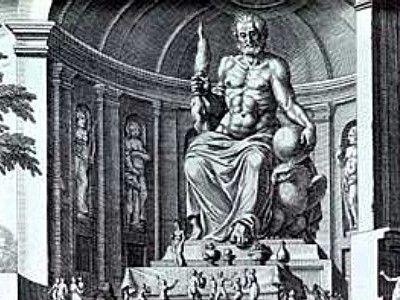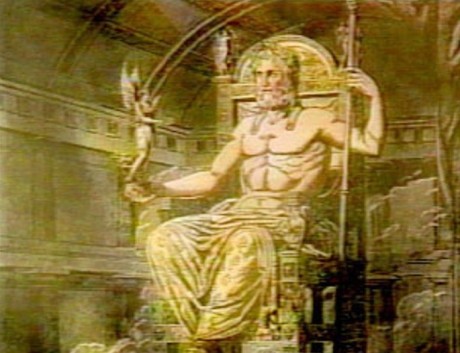The Statue of Zeus at Olympia is one of the seven ancient wonders of the world, which was built by famous Greek sculptor Phidias, approximately 432 BC.
It’s worth to be mentioned that the Statue of Zeus is one and only creation from the other six worlds’ ancient wonders which was located on the Europe Continent.

Furthermore, it was considered to be the most famous artistic work in all of Greece and made profound and intense impressions of the viewer. The philosophers, ancient travelers, writers were certainly amazed when they witnessed the beauty of this statue. Philo of Byzantium, was one of those whose manuscripts about all of the wonders were kept till today, but when you glance through them the inspiration and ardor is felt while he touches the theme of the king of the Gods, Zeus.
He wrote “Whereas we just wonder at the other six wonders, we kneel in front of this one in reverence, because the execution of the skill is as incredible as the image of Zeus is holy…” To the Greeks the statue of Olympian Zeus was the incarnate god, and not to have seen it at least once in one’s lifetime was considered a misfortune.

Olympic Games were the reason once every four years when all the wars, between the countries declared truce, conflicts were terminated in order to give safe passage to the athletes to travel from distant lands, including Asia Minor, Syria, Egypt and Sicily, to participate, compete and shrine the King of their gods, Zeus, in honor of which this most important festivals, the Olympic Games were organized. Olympics started in 776 B.C and it helped to unify the Greek city-states.
The spot where the competitions were actually held consisted of a stadium and a sacred grove, or Altis, where a number of temples were located. The worshiping to Zeus here was simple and ordinary in the early years, but as time went by and the games increased in importance, it became obvious that a new, larger temple, one worthy of the King of the gods, was needed. Thus, the construction on a new temple started between 470 and 460 B.C.,.
Thus the temple followed already well-maintained and often used design of large Grecian temples; it showed some similarities towards the Parthenon in Athens and the Temple of Artemis in Ephesus. The outlook of the temple was like this: it was built on a raised, rectangular platform. Thirteen large columns supported the roof along the sides and six supported on each end. The temple was covered with gently-peaked roof, where the pediments depicted the twelve labors of Heracles.

Even though the temple was considered one of the best examples of the Doric design because of its style and the quality of the workmanship, it is not the one which was declared as the ancient wonders of the world. However, a statue of Zeus specially made for the interior, to make it more superficial, otherwise it was too simple and usual for worshiping the god of the gods. When some philosophers argue that statue didn’t fit the interior of the temple, even though it was quite big, others assume that the proportions were very effective in conveying the god’s size and power.
Sometimes it said that Zeus presided over the Olympic Games. As much as he was ruling over the gods from his exalted throne on the top Mount Olympus, Zeus was eligible to see everything, reward good conduct, punish evil, and govern all. Greeks thought that he was the bringer of thunder and lightning, rain, and winds, and his weapon was the thunderbolt. He was the protector of cities, the home, strangers and supplicants. This sublime feelings and attitudes towards Zeus conditioned that the sculptor chosen for this great task, man named Phidias sculptured the figure of Zeus as it nearly grazed the roof.
Talking about the person who was honored to do this great job, the best work of his life, Phidias was already quite experienced and well-known as he had already rendered a forty-foot high statue of the goddess Athena for the Parthenon in Athens and had done much on the exterior of that temple itself. After arriving on Olympia he set up the workshop to the west of the temple and it took 12 years to complete the project.
The seated statue of Zeus itself was about 43 feet (12 meters) tall, 22 feet (10 meters) wide. The technique by which the statue was constructed is known as chryselephantine, where gold-plated bronze and ivory sections were attached to the wooden flame. Withstanding the fact that the weather in Olympia was so humid, the statue required the essential care. It’s said that Phidias held the responsibility for this maintenance for centuries. Thoughtful and creative Phidias invented the method of treating it with olive oil, which also served as reflecting pool and gave the effect of illuminating the statue. The figure’s skin itself was composed of ivory and the beard, hair and robe of gold. Perhaps even more impressive than the statue it was the throne made out of gold, ebony, ivory and inlaid with precious stones.

In his right hand the statue held the figure of crowned Nike, the goddess of victory, also chryselephantine and in its left was a scepter with an eagle perched on the top. Carved into the chair were figures of Greek gods and mystical animals, including the half man/half lion sphinx.
The date of the statue, the third quarter of the 5th century BC, long a subject of debate, was confirmed archaeologically by the rediscovery and excavation of Phidias’ workshop.
The sculptor of this world-famous statue after returning to his home-city was accused of stealing the gold meant for the statue of the goddess Athena and ended up his life in jail. However his masterpiece continued to live and astonish visitor’s eyes until it was damaged in an earthquake in 170 B.C. and then repaired. However, much of its majesty was probably lost after Emperor Constantine decreed that gold be stripped from all pagan shrines after he converted to Christianity in the early fourth century A.D.. Then in 392 A.D. the Olympics were abolished by Emperor Theodosius I of Rome, a Christian who saw the games as a pagan rite. After that according to the Byzantine historian Georgios Kedrenos, the statue was moved by a wealthy Greek named Lausus to the city of Constantinople where it became part of his private collection of classical art. It is believed that the remains of the statue were destroyed by a fire that swept the city in 475 A.D.. However, other sources say the statue was still at the Olympic Temple when it burned down in 425 A.D..
The greatest discovery around this sculpture came in 1954–1958 with the excavation of the workshop at Olympia where Phidias created the statue. Tools, terracotta moulds and a cup were found at the site. The Cup extensively showed the inscribed “I belong to Phidias” note and furthermore that was a place where the traveler Pausanias said the Zeus was constructed. This has enabled archaeologists to re-create the techniques used to make the great work and confirm its date.
Of course the copies of the statue were made, but none of them survive, though pictures found on coins give researchers clues about its appearance.

Thus, one thing is true, the statue of Zeus, during the centuries was such an impressive, exciting and powerful image of god that, “If a man, with a heavy heart from grief and sorrow in life, will stand in front of the statue, he will forget all these.”

Trackback
by Homes Olap
15 Dec 2011 at 15:02
Thanks very significantly for the challenging operate to give this kind of very good facts. I will forward your web page to my friends to discover from this beneficial article….